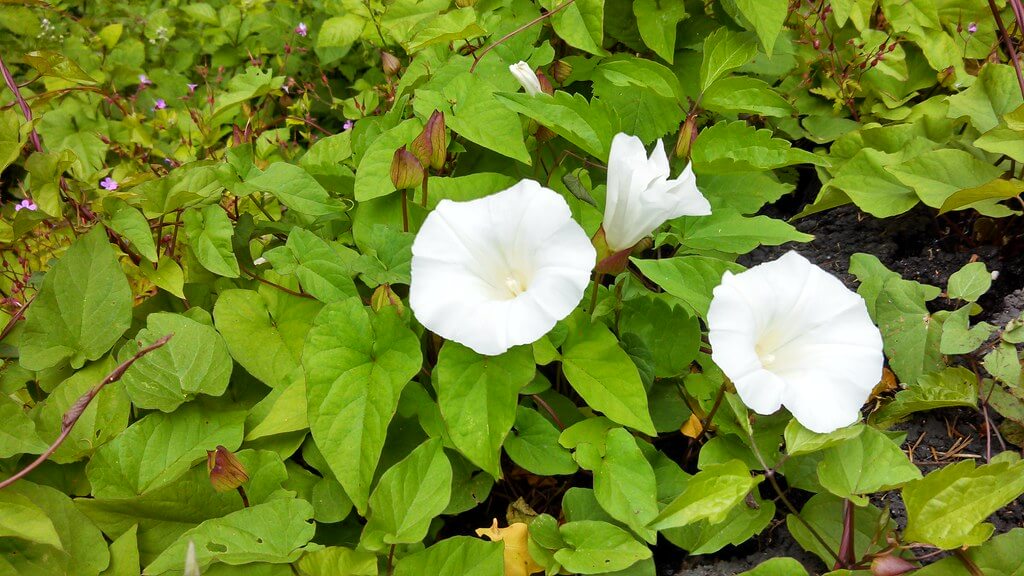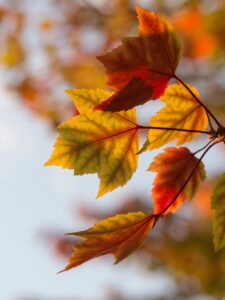Stop Invasive Vines from Climbing Shrubs, Fences, & Brick Walkways
Do you have English ivy stubbornly climbing up against your stone home or on your stately trees?
It’s time to take action to remove pesky vines from your Jamison landscape.
Summer Landscape Maintenance in Jamison, Warminster, & Doylestown
As summer starts to wind down in August, you’ll notice that viney weeds are taking over your property. These vines aggressively grow over your prized shrubs, up tree trunks, and along the side of your home.
How do you stop them?
In this blog post, you’ll learn the following tools for fighting back climbing vine weeds before they smother your plants and cause damage to your home:
- Get Rid of Weedy Vines Before They Damage Your Landscape
- Climbing Vine Weeds to Watch Out for This Summer
- Jamison Lawn Care Summer Landscape Maintenance Includes Invasive Weed Removal.
Let’s start with why removing weedy vines now can save your landscape from severe damage.
Get Rid of Weedy Vines Before They Damage Your Landscape
You don’t want vining weeds taking over your patio, walkways, fences, trees, shrubs or home. Instead, you want to be proactive because weedy vines do the following damage:
- Smother and kill garden plants by blocking the sunlight that leads to your desirable plants dying.
- Climb homes, fences, and hardscapes, making them look messy and structurally weaker. Some vines, such as English ivy, Mile-a-Minute, Oriental Bittersweet, Japanese Hops, and Kudzu, can overtake structures if they’re not stopped in time.
- These vines grow quickly and form thick vegetation, making them harder to remove and subjecting the structure or plants to damage and death.
Learn more: From Neglect to Flourish: The Importance of Committing to a Lawn & Landscape Plan
Now that you know the damage that viney weeds can do, here are the top offenders for Southeastern PA.
Climbing Vine Weeds to Watch Out For This Summer
Many vine weeds are invasive species, but some of them are native plants that are just as invasive, including poison ivy. You don’t want to allow any weedy vines to get a foothold on your property because they’re difficult to remove.
It may take years to fully eradicate certain weeds from your landscape, especially if they’re well-established.
Here are the top six weedy vines that cause property and plant damage in Bucks and Montgomery Counties:
- Bindweed
- English Ivy
- Japanese Honeysuckle
- Mile-a-Minute Vine
- Oriental Bittersweet
- Poison Ivy.
Each of these weedy vines brings its own set of issues. Let’s break down each vine to see if it’s plaguing your landscape:
- Bindweed
There are two types of bindweed in Pennsylvania: Hedge bindweed, also known as large bindweed, great bindweed, devil’s vine, lady’s nightcap, and wild morning glory.
Hedge bindweed can grow up to 10’ tall. It’s a native vine, in the same family as morning glory. Its leaves are triangular-shaped with a pointed tip and distinct, angular, squarely-cut lobes. Hedge bindweed has shallow roots, and its vines grow counter-clockwise.
Field bindweed, known as creeping Jenny, devil’s guts, field morning glory, or small bindweed has smaller, with a rounded-tip shape, like an arrowhead. Leaves are smaller at 1.5 to 2.5” long and 2” wide.
Field bindweed’s root system is more sophisticated than hedge bindweed. It forms dense mats on the ground, spreading to find anything to climb up, over, or through.
This bindweed spreads through an underground network of roots and rhizomes, which spread horizontally and vertically.
- English ivy
Most folks are familiar with English ivy—its emerald green leaves and its ability to take over a home’s façade or a fence. It also strangles landscaped plants and takes over garden beds if not managed or eradicated.
People still use English ivy as a ground cover, not realizing that it’ll take over the entire landscape, and, if left unchecked, will take over trees, homes, and other structures.
- Japanese honeysuckle
No doubt you recognize Japanese honeysuckle in June with its sweet fragrance. However, this invasive weed is considered a Class B Noxious Weed in Pennsylvania because there’s no hope of totally eradicating it.
Japanese honeysuckle loves sunny conditions and has no predators. Deer ignore it, and higher concentrations of CO2 encourage rapid growth. Also, it’s an evergreen and will continue to grow, even in wintertime.
Japanese honeysuckle will shade out any plant competition. Additionally, it’s a vining weed that’s fast-growing. Japanese honeysuckle not only damages gardens and landscapes, but it also causes weak trees to fall, as well as climbs over homes and fences.
Learn more: If You Keep Up with Weeding, You’ll Have a Tidy Landscape
- Mile-a-Minute
Another Class B Noxious Weed in Pennsylvania, Mile-a-Minute grows quickly and grows to 25’ in one season in both shady and sunny areas. This vine not only takes over, but it has barbs.
This vining weed spreads through birds who love the plant’s berries. It also doesn’t have a significant root system, making it easier to pull up the weed.
This weedy vine will damage both landscape and garden plants as well as homes and hardscapes by smothering and climbing.
- Oriental bittersweet
This vining weed is not native to the U.S. and has nearly replaced American bittersweet.
Oriental bittersweet is a woody, perennial vine that spreads through orange-red roots that sucker and stems that root where they touch the ground. It has orange berries, and the plant spreads by birds eating the berries as well as by folks who plant the seeds.
This viney weed grows quickly and becomes very large, blanketing and killing trees by blocking sunlight. Oriental bittersweet can also climb homes and other outdoor structures, leading to property damage.
- Poison Ivy
While poison ivy is considered a native plant, it’s a destructive weedy vine that takes over landscapes and gardens by climbing and choking other plants. It also likes to grow up on trees, telephone poles, fences, and other structures.
Because it contains urushiol, which is found in all parts of the plant—dead or alive, it usually causes a rash, sometimes severe, depending on the person. You need to wear gloves, long sleeves, and pants to remove this weed from the ground safely.
For larger installations, you need to use a cut stump weed control to destroy it. Experts advise looking out for this weed regularly and removing it when the plants are small to reduce problems later on.
If these invaders are taking over your property, it’s time to take action.
Jamison Lawn Care Summer Landscape Maintenance Includes Invasive Vine Removal
Suppose you have any of these invasive vines crawling up your home or trees, smothering shrubs and other perennials, or covering up your fencing. In that case, you need Jamison Lawn Care’s summer landscape maintenance services.
We remove viney weeds. You can choose from hand-pulling, herbicides, or a combination of both. Keep in mind, we can’t hand-pull weeds in brick walkways or other similar hardscapes, so we’ll need to apply weed control to stop the vines in their tracks.
Schedule your Invasive Vine Removal Today
If you’re tired of the chaotic look of viney weeds taking down your trees, covering your fences, or choking your landscape, fill out our contact form today!
Sources:
Extension.PSU.edu, Mile-a-Minute.
Ibid., The Noxious, Persistent, Invasive, and Perennial Bindweeds.
Ibid., Weed Identification and Control.
Extension.UMD.edu, Invasive Vine and Groundcover Control.
PA.gov, Controlled Plant & Noxious Weeds Lists.
YardandGarden.Extension.IAState.edu, How to Control Poison Ivy.





